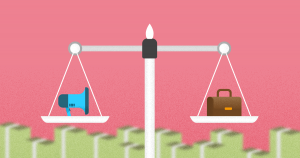Many people are interested in beginning a career as a freelancer for many different reasons.
Freelancing allows you to be your own boss, expand your repertoire, and earn extra income.
However, it can also be an uncertain career without any guaranteed salary or benefits, making some people wary of jumping into freelancing full-time and leaving their established careers.
Many people choose to start freelancing while keeping their full-time job in order to ensure they are still earning a salary and won’t be left without any monthly income as they find freelance clients and build a reputation.
Learning how to balance freelance work with a full-time career is challenging, but can definitely be done.
In this article, we’ll help you learn some tips and tricks for balancing freelance work while maintaining your traditional career and for making both jobs work for you.
- 1. Identify What is Important to You
- 2. Avoid Working Overlapping Hours
- 3. Use Different Tools and Devices to Separate Work
- 4. Try Freelancing with a Partner
- 5. Focus on Your Finances
- 6. Consider Clients in Different Time Zones
- 7. Perfect Time Estimates
- 8. Prioritize Full-Time Work First
- 9. Set Clear Boundaries with Freelance Clients
- 10. Learn How to Say No
- 11. Avoid Burnout
- 12. Block Out Distractions During Freelance Work
- 13. Double-Check Your Full-Time Contract
- 14. Enjoy the Work You Do
- 15. Know Your Limits
1. Identify What is Important to You
Learning how to balance freelance work and a full-time job means that you likely won’t have a lot of free time.
If you notice that you have evenings that are open, then this shouldn’t be too much of a problem, but if you have other hobbies or responsibilities that take up your free time, you may need to evaluate what is important to you and how much time you have during the day for freelance work.
2. Avoid Working Overlapping Hours
If you have a slower day at your full-time job, it can be tempting to do some freelance work during the same time frame.
However, this can lead to complications and can frustrate your full-time team.
By keeping separate hours and avoiding overlap between freelancing and your full-time job, you can make sure that you are separating the two careers and putting your full effort into each at the right time.
3. Use Different Tools and Devices to Separate Work
If you try to complete both freelance work and your full-time work on the same tools and devices, it can also be difficult to keep things separated and avoid overlap.
By having separate devices and tools, you can easily ensure that your freelance work isn’t bleeding into your full-time job.
Try having two computers, one for full-time work and one for your own use, in order to avoid overlap with passwords, tools, and software programs.
4. Try Freelancing with a Partner
When we think of freelancing, we often think of solo work. However, you can definitely do freelance work with a partner or a small team.
This can be a great way to get started when you are still working in a full-time career.
You can handle specific tasks in the partnership that require less time or can be done at times outside of your other working hours, and allow your partner to manage the other tasks to help you balance your work.
5. Focus on Your Finances
One of the biggest reasons that a person considers freelancing is to earn extra income and get more money in the bank each month.
By focusing on finances, you can mentally overcome some of the barriers that can hinder your freelance growth while working a full-time job.
Thinking of finances can help you get up an hour earlier to work on a freelance project or work over the weekend to get a new freelance client.
6. Consider Clients in Different Time Zones
If you work with freelance clients in your own time zone, you can find yourself struggling to meet their demands while working the hours needed in your full-time job.
By having clients in different time zones, you can give yourself the space of a few hours in order to do work outside of traditional office job hours.
It also allows you to find clients across the globe who can help your freelance career.
7. Perfect Time Estimates
Freelance work is often charged by the hour, and knowing how long it takes to complete a freelance job is essential to doing a good job.
When you have a limited number of hours to do freelance work, you want to make sure that you have time for the projects you take on.
By knowing how long it takes to do different tasks, you can set clear time estimates and avoid over-committing when you don’t have the time to take something on.
8. Prioritize Full-Time Work First
If you find that your plate is full of both freelance and full-time work, it can be difficult to know what to prioritize.
As a best practice, you should always put your full-time work first.
Your full-time career is likely where the majority of your income and benefits come from, and you want to make sure your managers and bosses are pleased with your work and your commitment to the team or organization.
9. Set Clear Boundaries with Freelance Clients
Having clear boundaries and expectations for your freelance clients is another essential step in learning how to balance freelance work with a full-time career.
Make sure your freelance clients know when you are available to talk and when you aren’t going to be able to take calls or requests.
This also helps you build a good reputation as a freelancer and gain additional skills that will serve you in your freelance career in the future.
10. Learn How to Say No
One of the hardest parts of freelance work is having to turn down potential clients or projects.
This is even more challenging when you are still working a full-time job and have limited time to do freelance work.
However, it’s important that you be realistic about what you can accomplish.
It’s better business to tell a potential client that you are booked out rather than taking on a project that is constantly delayed or isn’t done well due to time constraints.
11. Avoid Burnout
Burnout is a condition of stress that can occur when you work too hard and don’t have enough outlets and time away to refocus yourself.
When you work both a freelance and full-time career, burnout can come quickly.
Make sure that you aren’t booking yourself so solid that you don’t have time to enjoy your personal life or your friends and family.
Take time off when you can and enjoy time away from work.

12. Block Out Distractions During Freelance Work
Because freelancing means you are your own boss and don’t have any direct managers or supervisors, it can be easier to space out or be unfocused during your freelance work hours.
In order to remain focused and combat your inefficiency, it helps to completely block out distractions.
Have dedicated freelance hours where you are undisturbed and also where you are left alone in order to meet your freelance responsibilities.
13. Double-Check Your Full-Time Contract
Some jobs and careers have clauses in their employee contracts that limit your freelance opportunities.
Certain non-compete clauses or even freelance bans can mean that you don’t have many options for freelancing.
It always helps to make sure that everything is legal and that you aren’t breaking any rules in your contract.
Double-check your full-time contract and ensure that what you are doing is legal, or check with HR if you have questions.
14. Enjoy the Work You Do
Working both a freelance and full-time career can be draining, but ultimately it should be rewarding.
Make sure that you are enjoying the work you do and that it is providing enough benefits to be enjoyable and worthwhile.
Try picking different freelance projects or finding new full-time opportunities so that you don’t end up dreading your work day.
This will help you remain committed to both careers and find the time in your day to make sure you are putting in your best efforts.
15. Know Your Limits
There may come a day when you realize it’s time to say goodbye to either a full-time or freelance career.
If you are getting enough freelance business to feel confident in going full-time with freelancing, you may want to quit your traditional career.
Likewise, if freelancing is just getting in the way of your time with friends and family, it might not be the best fit right now.
Know your limits and understand that there’s no shame in going back to a single career rather than balancing two jobs.
You may also be interested in these articles:
- Freelancers ROI: How to calculate the ROI of your freelance projects
- 10 Key Questions Freelancers Should Ask Clients to Succeed
- 7 Freelancers Mistakes to Avoid
Freelancing can be an uncertain career path, particularly for those who are just starting out.
Keeping a full-time career while you begin freelancing can help you maintain a steady income and avoid some of the uncertainties that can arise with freelancing.
When you know how to balance freelance work with your traditional career, you can revive the benefits of both career paths and work on moving towards the future you envision.
If you are considering a freelance career, then you must know about the best freelance sites to find jobs.
Just click on the link to see our selection of the top opportunities!








